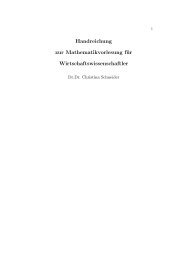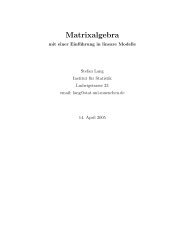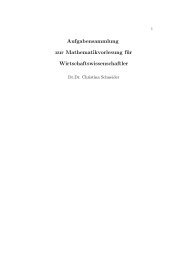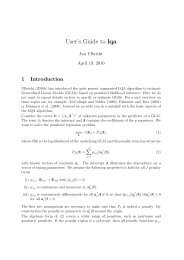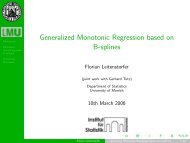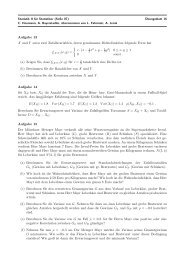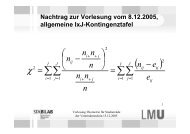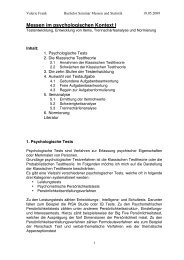Statistik II für Statistiker, Mathematiker und Informatiker (SS ... - LMU
Statistik II für Statistiker, Mathematiker und Informatiker (SS ... - LMU
Statistik II für Statistiker, Mathematiker und Informatiker (SS ... - LMU
Sie wollen auch ein ePaper? Erhöhen Sie die Reichweite Ihrer Titel.
YUMPU macht aus Druck-PDFs automatisch weboptimierte ePaper, die Google liebt.
8. Mehrdimensionale Zufallsvariablen 8.4 Unabhängigkeit von Zufallsvariablen<br />
8. Mehrdimensionale Zufallsvariablen 8.5 Kovarianz <strong>und</strong> Korrelation<br />
8.5 Kovarianz <strong>und</strong> Korrelation<br />
E(X) = µ X , E(Y ) = µ Y ; V ar(X) = σX 2 ,V ar(Y ) = σ2 Y<br />
X <strong>und</strong> Y definiert, z.B.<br />
wie bisher separat <strong>für</strong><br />
Verallgemeinerung <strong>für</strong> n > 2 Zufallsvariablen:<br />
Die Zufallsvariablen X 1 , ...,X n heißen unabhängig, wenn <strong>für</strong> alle x 1 ,...,x n gilt<br />
P(X 1 ≤ x 1 ,...,X n ≤ x n ) = P(X 1 ≤ x n ) · . .. · P(X n ≤ x n ).<br />
Äquivalent dazu ist die Produktbedingung<br />
f(x 1 ,...,x n ) = f X1 (x 1 ) · . .. · f Xn (x n ),<br />
wobei f(x 1 ,...,x n ) die gemeinsame Dichte von X 1 , ...,X n <strong>und</strong> f Xi (x i ) die<br />
Dichte der Zufallsvariable X i bezeichnen (i = 1,...,n).<br />
µ X = ∑ x i p i·, σ 2 X = ∑ (x i − µ X ) 2 p i·<br />
= ∑ x i f X (x i ), = ∑ (x i − µ X ) 2 f X (x i )<br />
∫<br />
∫<br />
bzw. µ X = xf X (x) dx, σX 2 = (x − µ X ) 2 f X (x) dx<br />
• Kovarianz <strong>und</strong> Korrelation wichtigste Maßzahlen <strong>für</strong> Zusammenhang zwischen<br />
X <strong>und</strong> Y .<br />
• Definition in Analogie zu empirischer Kovarianz <strong>und</strong> empirischer Korrelation<br />
aus Kapitel 3.<br />
<strong>Statistik</strong> <strong>II</strong> <strong>für</strong> <strong>Statistik</strong>er, <strong>Mathematiker</strong> <strong>und</strong> <strong>Informatiker</strong> im <strong>SS</strong> 2007 60<br />
<strong>Statistik</strong> <strong>II</strong> <strong>für</strong> <strong>Statistik</strong>er, <strong>Mathematiker</strong> <strong>und</strong> <strong>Informatiker</strong> im <strong>SS</strong> 2007 61<br />
8. Mehrdimensionale Zufallsvariablen 8.5 Kovarianz <strong>und</strong> Korrelation<br />
8. Mehrdimensionale Zufallsvariablen 8.5 Kovarianz <strong>und</strong> Korrelation<br />
Definition: Kovarianz Cov(X, Y ) zwischen X <strong>und</strong> Y<br />
• X,Y diskret:<br />
Cov(X, Y ) = ∑ i<br />
∑<br />
j<br />
(x i − µ X )(y j − µ Y ) f(x i ,y j )<br />
} {{ }<br />
p ij<br />
Bemerkung:<br />
Für diskrete Zufallsvariablen völlige Analogie zu empirischer Kovarianz:<br />
µ X = ¯x, µ Y = ȳ, f ij = p ij<br />
Auch Interpretation analog.<br />
• X,Y stetig: ∑ −→ ∫<br />
∫ ∫<br />
Cov(X, Y ) =<br />
(x − µ X )(y − µ Y )f(x, y) dy dx<br />
Für stetige Zufallsvariablen werden entsprechende Beiträge<br />
(x − µ X )(y − µ Y )f(x, y) aufintegriert statt aufsummiert.<br />
<strong>Statistik</strong> <strong>II</strong> <strong>für</strong> <strong>Statistik</strong>er, <strong>Mathematiker</strong> <strong>und</strong> <strong>Informatiker</strong> im <strong>SS</strong> 2007 62<br />
<strong>Statistik</strong> <strong>II</strong> <strong>für</strong> <strong>Statistik</strong>er, <strong>Mathematiker</strong> <strong>und</strong> <strong>Informatiker</strong> im <strong>SS</strong> 2007 63



